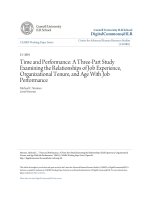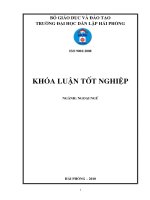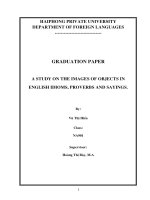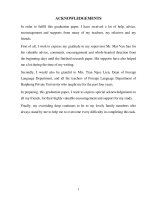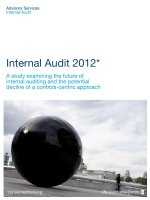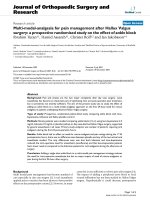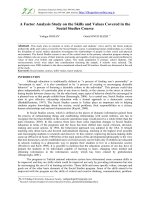Time and performance a three part study examining the relationships of job experience, organizational tenure, and age with job performance
Bạn đang xem bản rút gọn của tài liệu. Xem và tải ngay bản đầy đủ của tài liệu tại đây (222.94 KB, 44 trang )
Cornell University ILR School
DigitalCommons@ILR
CAHRS Working Paper Series
Center for Advanced Human Resource Studies
(CAHRS)
2-1-2001
Time and Performance: A Three-Part Study
Examining the Relationships of Job Experience,
Organizational Tenure, and Age With Job
Performance
Michael C. Sturman
Cornell University
Sturman , Michael C. , "Time and Performance: A Three-Part Study Examining the Relationships of Job Experience, Organizational
Tenure, and Age With Job Performance" (2001). CAHRS Working Paper Series. Paper 68.
/>
This Article is brought to you for free and open access by the Center for Advanced Human Resource Studies (CAHRS) at DigitalCommons@ILR. It
has been accepted for inclusion in CAHRS Working Paper Series by an authorized administrator of DigitalCommons@ILR. For more information,
please contact
Please take our short DigitalCommons@ILR user survey.
CAHRS / Cornell University
187 Ives Hall
Ithaca, NY 14853-3901 USA
Tel. 607 255-9358
www.ilr.cornell.edu/CAHRS/
WORKING PAPER SERIES
Time and Performance:
A Three-Part Study Examining the
Relationships of Job Experience,
Organizational Tenure, and Age with Job
Performance
Michael C. Sturman
Working Paper 01 – 05
Time and Performance
CAHRS WP 01-05
TIME AND PERFORMANCE:
A THREE-PART STUDY EXAMINING THE
RELATIONSHIPS OF JOB EXPERIENCE,
ORGANIZATIONAL TENURE, AND AGE WITH JOB
PERFORMANCE
MICHAEL C. STURMAN
Cornell University
School of Hotel Administration
541 Statler Hall
Ithaca, New York 14853
Tel: (607) 255-5383
Fax: (607) 254-2971
Special thanks to John Boudreau, Steve Caldwell, Wayne Cascio, Paul Jarley, Glenn McEvoy,
and Marty Wells for their help on previous versions of this paper.
/>This paper has not undergone formal review or approval of the faculty of the ILR School. It is
intended to make results of Center research available to others interested in preliminary form to
encourage discussion and suggestions
Page 2
Time and Performance
CAHRS WP 01-05
ABSTRACT
Theoretical and empirical research suggests that job experience, organizational tenure, and age
have non-linear relationships with performance. Considered simultaneously, there should exist
an inverted U-shaped relationship between time and performance. This paper includes three
studies — a meta-analysis, a cross-sectional sample, and a longitudinal sample—to test these
hypotheses. Together, the three studies provide complementary evidence supporting the
hypotheses. The set of results has implications for theory, research on dynamic performance,
and human resource management practice.
Page 3
Time and Performance
CAHRS WP 01-05
It has been long-studied, and now well-documented, that individual job performance is
dynamic (i.e., it changes over time) (Deadrick, Bennett, & Russell, 1997; Deadrick & Madigan,
1990; Henry & Hulin, 1987; Hofmann, Jacobs, & Baratta, 1993; Hoffman, Jacobs, & Gerras,
1992; Hulin, Henry, & Noon, 1990; Ployhart & Hakel, 1998). However, despite the fundamental
importance of predicting job performance to industrial-organizational psychology and
organizational practice, the field still knows relatively little about the nature of individual job
performance changes over time (Ployhart & Hakel, 1998). Although there is nothing inherently
causal about time (Hulin et al., 1990), some changes in job performance may be attributed to
effects approximated by temporal variables (Deadrick et al., 1997; Hofmann et al., 1992, 1993).
Variables such as job experience, organizational tenure, and employee age serve as easily
obtainable proxies for other constructs like job knowledge, physical skills, and organizational
socialization, and thus play crucial roles in human resource research and practice. For
example, theoretical models of work performance and behaviors frequently include job
experience, organizational tenure, and employee age (Ackerman, 1992; Campbell, 1990; Giniger,
Dispenzieri, & Eisenberg, 1983; Rhodes, 1983; Salthouse, 1979; Schmidt, Hunter, &
Outerbridge, 1986; Tesluk & Jacobs, 1998). Empirical research often employs these variables
as controls approximating job-related abilities, human capital characteristics, or motivational
factors (e.g., Forteza & Prieto, 1994; Quiñones, Ford, & Teachout, 1995; Lawrence, 1996;
Tesluk & Jacobs, 1998; Warr, 1994). In practice, job experience and seniority (i.e.,
organizational tenure) often play a significant part in human resource decisions (Campion,
Cheraskin, & Stevens, 1994; Gatewood & Feild, 2001; Olsen & Berger, 1983; Quiñones et al.,
1995; Tesluk & Jacobs, 1998). In sum, understanding the relationships of job experience,
organizational tenure, and employee age with performance is of critical concern for theory,
research, and practice. To contribute to the field’s understanding of generalizable changes of
performance over time, this paper examines the nature of the relationship between performance
and time over the span of employees’ careers.
Page 4
Time and Performance
CAHRS WP 01-05
This paper explores how the temporal variables of job experience, organizational tenure,
and employee age relate to employee job performance. The study uses theoretical work on the
effects of job experience, research on organizational socialization, and the decremental theory of
aging to explain (a) the relationship of these temporal variables with job performance, and (b)
how an inverted U-shaped relationship between time and performance results when these
relationships are considered simultaneously. This study then performs a multi-method
investigation to test the issues raised herein. First, using meta-analyses, this paper tests if the
variety of past findings of these relationships may be attributable to non-linear relationships.
Second, this paper performs analyses on a sample of employees who have spent their careers
within a single organization to illustrate the nature of the relationship between time and
performance. Third, this study examines the simultaneous effects of job experience,
organizational tenure, and employee age by modeling employees’ performance trends using a
longitudinal sample. The sum of the present study’s results should help inform dynamic
performance research on the theoretical need and practical value of including temporal variables
as predictors of individual change patterns. The results should also inform various fields on the
implications of temporal variables as predictor or control variables, particularly when used in the
prediction of job performance. Furthermore, the results should contribute to practice by helping
forecast employee performance.
DYNAMIC PERFORMANCE AND TEMPORAL VARIABLES
Job Experience
Experience can be defined as the culmination of context-based events that an individual
perceives (Quiñones et al., 1995). This definition provides a distinction between knowledge
accumulated through education and the process of actually performing a job. Within the context
of a job, experience entails the accumulation of job-specific knowledge from action, practice, and
perception of the tasks and duties associated with a specific job.
Page 5
Time and Performance
CAHRS WP 01-05
While the concept of experience seems straightforward, recent research into the
implications of its measurement shows it to be multifaceted (Quiñones et al., 1995; Tesluk &
Jacobs, 1998). Thus, despite much research using such approximations and terms for work
experience as job tenure, job experience, organizational tenure, and seniority interchangeably
(Hofmann et al., 1992), in-depth treatments of the variable suggest it varies by level of
specification (e.g., task, job, work-group, organization) and measurement (e.g., amount, time,
type, density) (Quiñones et al., 1995; Tesluk & Jacobs, 1998). It is beyond the scope of this
study to address every potential specification of experience. This paper focuses on experience
with a job (or set of highly similar jobs) involving multiple duties, which hereunto is referred to as
job experience, and experience with the organization (i.e., organizational tenure) to be discussed
later. Furthermore, as the focus here is on the relationships between temporal variables and
performance, job experience is examined through the quantitative measure of time (in years).
Several theories lend understanding to the relationship between job experience and
performance. Human Capital Theory suggests that employees make investments of experience
in themselves, which enhance their ability, and thus influence job performance (Ehrenberg &
Smith, 2000). Learning theory also predicts that job experience enhances job ability (Weiss,
1990). Both perspectives suggest that job performance changes over time because individuals
accumulate job experience. As job experience leads to the accumulation of relevant knowledge,
skills, and abilities, performance should improve. From this basis, models of performance posit
that job experience has a positive affect on job performance (e.g., Campbell, 1990; Hunter, 1983;
Schmidt, Hunter, & Outerbridge, 1986). Providing a detailed treatment of this hypothesis,
Schmidt et al. (1986) showed job experience influences job knowledge and task proficiency,
which in turn affect job performance. Their model also suggested that the effect of experience
may not be linear. Schmidt and colleagues argued that the relative advantage of one year of job
experience is significantly greater at lower levels of job experience than at higher levels
Page 6
Time and Performance
CAHRS WP 01-05
(McDaniel et al., 1988; Schmidt et al., 1986), a finding that has been replicated (Avolio,
Waldman, & McDaniel, 1990; McDaniel et al., 1988). Therefore, we hypothesize:
H1: There is a non-linear relationship between job experience and
job performance.
Organizational Tenure
Organizational experience suggests an accumulation of work-related information that is
conceptually distinct from job experience (Quiñones et al., 1995; Tesluk & Jacobs, 1998).
Accurate specification of the context through which experience is accumulated (i.e., job vs.
group vs. organizational level) furthers our understanding of relationships with critical variables
(Tesluk & Jacobs, 1998). The accumulation of organizational experience, or organizational
tenure, may have effects on individual development beyond those of job experience. The
literature on organizational socialization (e.g., Chatman, 1991; Feldman, 1976; Louis, 1990; Van
Maanen & Schein, 1979) most directly addresses the effects of accumulating organizational
experience.
Organizational socialization is the process by which an individual comes to understand
the social knowledge, values, and expected behaviors necessary to assume an organizational
role (Chatman, 1991; Van Maanen & Schein, 1979). Through socialization, employees learn
how to function within an organization’s culture by gaining familiarity with the organization’s
systems, becoming trusted by coworkers, and establishing friendships (Feldman, 1976).
Some have argued that when experience is measured at the organizational level of
specification, it is more appropriately linked to such phenomena as organizational commitment
rather than job performance (Quiñones et al., 1995; Tesluk & Jacobs, 1998). While
organizational experience may appear less directly related to job performance, the accumulation
of knowledge of expected behaviors and acceptance by coworkers should affect one’s
proficiency within an organization. Similarly, changes in the organizational environment may
lead to changes in job performance. Thus, measuring familiarity with the environment or how to
Page 7
Time and Performance
CAHRS WP 01-05
function within the organization captures a level of understanding beyond that explained by
changes in job experience over time. Take for example two research scientists, both with 10
years experience. All else equal, we would expect one with those ten years of experience within
the same organization to be more knowledgeable about how to get a project done (e.g., knowing
who to contact for help, building upon established relationships with colleagues, locating
resources, and obtaining necessary information or supplies) than another scientist who is just
beginning to work for the organization. As with job experience, though, the benefit of
accumulated organizational experience on job performance is likely to change over time. We
would expect that socialization is most pronounced for new employees as compared with
veteran employees. Thus, any effect of organizational tenure on performance should be nonlinear: with a larger positive effect at low levels of organizational tenure and with a diminishing
effect as organizational tenure increases. Therefore, we predict
H2: There is a non-linear relationship between organizational tenure
and job performance.
Age
Simultaneous to the accumulation of job experience and organizational tenure, the
individual necessarily is getting older. Thus, aging may also play a role in describing how an
individual changes over time, and subsequently may affect how performance changes over time
(Waldman & Avolio, 1993).
There has long been a view of a negative age-performance relationship (Rhodes, 1983),
although the belief has endured without conclusive empirical support (McEvoy & Cascio, 1989).
One theoretical rationale for the hypothesized negative relationship is the decremental theory of
aging (Giniger, et al., 1983), which suggests that increased age causes a deterioration in
abilities, such as speed, dexterity, motor coordination, and strength (Giniger et al., 1983;
Rhodes, 1983; Salthouse, 1979). Similarly, Kliegl and Mayr (1992) have advanced a model that
suggests there is an underlying single negative affect of age-related influences on a wide range
Page 8
Time and Performance
CAHRS WP 01-05
of cognitive variables. Although the simplest single factor model (i.e., one underlying factor,
affected solely by age, accounts for all declines in cognitive functions) has been shown to be too
simplistic, a large number of studies do present evidence of the negative effects of aging, and a
form (albeit somewhat more complex than the simplest model) of the single factor model is
strongly supported (Verhaeghen & Salthouse, 1997). Notably, age has also been shown to be
associated with decreases in performance on tests of learning, memory, reasoning, spatial
abilities, and psychomotor speed (Lindenberger & Baltes, 1994; Salthouse, 1991; Schaie &
Willis, 1993; Verhaeghen & Salthouse, 1997).
Aging may also affect performance through motivation. Wright and Hamilton (1978)
suggest that older employees go through a "grinding down" stage where they accept what is
available to them and lessen their expectations. Supporting this proposition, empirical work
demonstrates a negative relationship between age and ambition, aspirations, and overall
motivation (Giblin, 1986; Judge & Hulin, 1993; Judge & Locke, 1993; Kuhlen, 1977; Rhodes,
1983; Slocum, Cron, Hansen, & Rawlings, 1985).
Aging may also affect how others perceive, and therefore treat, an individual. Research
suggests that older workers are evaluated more harshly than younger workers (Cleveland, &
Landy, 1983, 1987; Siegel & Ghiselli, 1971), are given raises less readily (Siegel & Ghiselli,
1971), and are offered fewer training and networking opportunities (Kuhlen, 1977; Lawrence,
1988). Thus, even if an individual does not change in terms of performance-causing
characteristics, other employees may fulfill their own expectations of performance changes by
reducing opportunities for performance or development, or by giving lower evaluations.
Despite the theory suggesting that aging will affect performance, and empirical evidence
showing aging’s effects on performance-related constructs, research on the age/performance
relationship has shown mixed results. Rhodes (1983) reported approximately equal numbers of
studies with positive, negative, and no relationships. Meta-analyses have shown that age alone
accounts for little variance in job performance (McEvoy & Cascio, 1989; Waldman & Avolio,
Page 9
Time and Performance
CAHRS WP 01-05
1986). It should be noted that not all examinations of aging suggest negative effects. In
particular, crystallized intelligence (e.g., Cattell, 1963)—which entails the cognitive processes
and abilities that are embedded in learned cultural meaning, acquired through prior experience
(Warr, 1994)—has been found to be higher among older people (Dixon, Kramer, & Baltes, 1985;
Labouvie-Vief, 1985). Others have made similar arguments, that while physical and mechanical
abilities may decline over time, pragmatic abilities may increase (Salthouse, 1995). Thus,
performance may remain constant at higher age levels because job experience may
compensate for any detrimental affect of aging (Tesluk & Jacobs, 1998). Accounting for
experience, though, should reveal the relationship with age (Avolio et al., 1990).
The theoretical position positing a relationship between age and performance does not
imply that the effect of age on performance is linear. Again, we expect a non-linear relationship,
with the negative effects of age becoming stronger as employees age. Thus, the total
relationship between employee age and job performance should be non-linear (Avolio et al.,
1990). Evidence supporting this position is mixed. McEvoy and Cascio (1989) found some
support for a curvilinear hypothesis. Specifically, they examined studies with young employees
versus those of all ages and found that the young samples had a higher age/performance
correlation than the other studies. While this result is informative, as no other meta-analysis had
yet examined such a moderator, it is limited in that it had only a few studies in the younger group
(K= 4 in one analysis; K = 9 in another). More importantly, it did not treat age as a continuous
variable and thus did not examine the potential non-linear relationship between age and
performance over the plausible range of age values. Others have found support for non-linear
effects of age, but lacked a sufficient range (particularly of older workers) in the sample to fully
test the nature of the age/performance relationship at all values potentially facing modern
employers (Avolio et al., 1990). For these reasons, stronger support of a non-linear relationship
may not have been detected by this previous research, and further work is necessary to
substantiate this proposed non-linear relationship. Furthermore, no study has looked for a non-
Page 10
Time and Performance
CAHRS WP 01-05
linear relationship between age and performance after controlling for the effects (and in
particularly, non-linear effects) of job experience and organizational tenure. Based on available
theory, and in line with previous predictions (e.g., Giniger et al., 1983; McEvoy & Cascio, 1989)
this paper posits
H3: There is a non-linear relationship between age and job performance.
Considering Temporal Variables Simultaneously: The Inverted U-Shaped Hypothesis
In sum, the literature relevant to understanding how temporal variables relate to job
performance describe two key phenomena. First, job experience and organizational tenure are
expected to have positive relationships with performance, but the strength of this effect is
expected to diminish over time. Second, employee age should be negatively related to
performance, with the effect increasing in magnitude as age increases. These effects should
operate simultaneously. Furthermore, it is important to note that the strength of the effects
varies over time. Thus, the positive effects of job experience and organizational tenure should
be initially strong, but grow weaker over time; simultaneously, the expected negative effects of
age should be at first small, but become increasingly stronger while the positive effects of
experience and seniority are diminishing. Note that because the expected magnitude of the
forces changes over time, their effects should not simply cancel each other out. Rather, the
combination of these forces should yield an inverted U-shaped relationship between time and
performance (Avolio et al., 1990).
The hypothesis of an inverted U-shaped relationship between time and performance is a
proposal that individual job performance follows a given, generalizable pattern over individuals’
careers. This is in contrast to an implicit null hypothesis that performance is unrelated to time.
This null hypothesis suggests that, for performance prediction, individual job performance
regresses to an overall grand mean (zero in standardized units), which further suggests that
when considering performance over time, changes in performance would in part be captured by
the tendency to regress to this mean. The inverted U-shaped hypothesis proposes that
Page 11
Time and Performance
CAHRS WP 01-05
individual job performance does not regress to a single overall grand mean with the passage of
time; rather, performance follows a generalizable pattern with time, and thus some of
performance dynamism may be attributable to the changes captured by this inverted U-shaped
curve. Thus, for the development of performance theory related to dynamic performance, and
for the purpose of informing empirical research exploring the nature of performance over time, it
is important to search for generalizable patterns of performance over employees’ careers. Note
that this proposition of an inverted U-shaped relationship is not new (e.g., Avolio et al., 1990;
McEvoy & Cascio, 1989; Rhodes, 1983); however, previous research has failed to provide
conclusive empirical evidence either for or against this relationship (McEvoy & Cascio, 1989;
Rhodes, 1983). The search for this inverted U-shaped hypothesis remains important for
research and practice to confirm or falsify the notion that there exists generalizable changes in
individual job performance levels over the span of individuals’ careers.
The lack of support in the literature for an inverted U-shaped relationship may be
attributable to the lack of older workers in examined samples. This would make the observation
of the inverted U-shaped relationship difficult. For example, the McDaniel et al. (1988) study
clearly demonstrated a non-linear relationship between experience and performance; however, it
only investigated the experience/performance relationship for a population with an average
experience of less than 6 years, and their last reference group in their analysis was "12 years
and up." Thus, although the study did not provide support for the existence of an inverted Ushaped relationship, due to its lack of range, their study did not provide evidence to the contrary.
Avolio et al. (1990) investigated the age/performance and experience/ performance relationships.
They too found non-linear relationships, but failed to support (or reject) the notion of an inverted
U-shaped curve for the majority of their sample. Avolio et al. (1990) did find, however, that the
non-linear terms in all of their equations were significant and negative. The negative non-linear
terms means that the positive relationship of age and experience with performance diminishes at
higher levels, and may even become negative and form an inverted U-shape. Had the Avolio et
Page 12
Time and Performance
CAHRS WP 01-05
al. (1990) sample included more older employees, they might have supported the inverted Ushaped hypothesis; however, only 6% of Avolio et al.'s (1990) sample were aged 55 or more.
The trend toward increased workforce participation by older individuals (Ahlburg &
Kimmel, 1986; Warr, 1994) combined with more frequent employee movements between jobs,
organizations, and careers (Hall & Associates, 1996; Hall & Mirvis, 1995), suggests that
organizations will increasingly encounter diverse ranges of job experience, organizational tenure,
and age levels. This trend highlights the need for research to explore the temporal variable/
performance relationships over a wider range of the time-related variables. This paper posits
that there are theoretical reasons to expect an inverted U-shaped relationship between time and
performance which, although potentially difficult to observe, should help predict individual
performance levels over employees’ careers. Thus, the joint review of job experience/
performance, organizational tenure/performance, and age/performance relationships suggests
the following hypothesis:
H4: There exists an inverted U-shaped relationship between temporal
variables (i.e., job experience, organizational tenure, and employee
age) and job performance.
METHODS
Fully testing this study’s hypotheses presents a major methodological challenge because
it requires substantial ranges of the independent variables (i.e., job experience, organizational
tenure, and employee age). Given the modern trends toward frequent employee movements
between jobs, organizations, and careers (Hall & Associates, 1996; Hall & Mirvis, 1995), data
sets with high levels and diverse ranges of job experience and organizational tenure are
increasingly rare. Furthermore, if such data sets are obtainable, they may lack generalizability to
more typical samples. Yet the very trends that make finding samples with high levels of job
experience and organizational tenure less likely also increase the diversity of these values
across workplaces, underscoring the need to investigate how these variables simultaneously
Page 13
Time and Performance
CAHRS WP 01-05
relate to performance. To provide a balance between finding data sets allowing comprehensive
tests and producing results generalizing to other settings, this study employs multiple methods
and data sources to yield a more complete picture of the variables’ relationships.
First, this paper employs meta-analyses to determine if data used in previously published
studies conform to the study’s hypotheses. Although a large number of studies have examined
relationships between the temporal variables of interest in this paper and performance, few have
examined potential non-linearities. Consideration of the hypothesized non-linear relationships
between temporal variables and performance may help explain the variance of prior findings and
the inability of prior meta-analyses to explain a substantial portion of such variance. This study
employs a meta-analytic method that includes testing continuous covariates, and thus allows the
investigation of non-linear relationships. The advantage of this method is that previous studies’
results should provide confirmatory evidence of the temporal variables’ non-linear relationships
with performance, and of the inverted U-shaped relationship. An advantage of the meta-analysis
methodology is that it can show generalizable findings across the published literature (even
though this literature did not initially examine or test for these non-linearities); however, it only
presents a summary of results of a single temporal variable/performance relationship at a time,
at a group level of analysis, and without controlling for the effects of the other temporal variables.
Demonstration of the findings would also be desirable at the individual level of analysis.
Second, this paper examines cross-sectional data from a single large company to help
demonstrate the inverted U-shaped phenomenon and illustrate the simultaneous effects of time
on individual job performance. This organization’s human resource practices encourage a highly
stable employee population: it employs a policy of internal promotion for all but entry level
positions; its employees tend to stay with the company for their entire careers; and job
movements within the organization build upon the experiences of previous job assignments.
Thus, this data sets affords us the opportunity to test the inverted U-shaped hypothesis on a
Page 14
Time and Performance
CAHRS WP 01-05
sample of employees where job experience, organizational tenure, and age are operating
simultaneously (albeit nearly collinearly) and over a wide range of time values.
Third, this paper uses longitudinal design to demonstrate the temporal variables’ nonlinear relationships while simultaneously controlling for the linear and non-linear effects of the
other temporal variables. This sample is advantageous because it allows the examination of all
three temporal variables simultaneously. Furthermore, because it is longitudinal, it is possible to
examine how these temporal variables relate to both the level of performance and how
performance changes over time. However, because job experience, organizational tenure, and
age vary widely (i.e., because, like many workplaces, employees are hired with various
experience levels, at various ages, and may move within the company and thus have various
organizational tenure levels), this sample does not afford a good opportunity to examine the
inverted U-shaped hypothesis.
Although every methodological approach has its weaknesses, using a broad range of
data sources and analytical methods helps present a comprehensive test of the study’s
hypotheses. The specific methods and results for each part are described below.
Study One
Meta-analytic approach. The first set of analyses investigate the study’s hypotheses by
quantitatively reviewing literature on job experience and performance, organizational tenure and
performance, and age and performance. The expected non-linear relationships suggest that
observed correlations in studies are not random samplings of a single true correlation
coefficient; rather, the observed correlation for a given study depends on the level of the temporal
variable of the subjects being studied. For example, the observed correlation between job
experience and performance for a sample depends on the subjects’ job experience levels. So,
a sample with a mean experience of 2 years or fewer should have a different (greater)
correlation than a sample with a mean experience of 15 years. Because correlations
summarize data at the group level, we would therefore expect the hypothesized non-linear
Page 15
Time and Performance
CAHRS WP 01-05
relationships to appear through study’s correlations being a function of the mean level of the
temporal variable for the sample.
Although a number of methods of meta-analysis exist which could be used to test this
study’s hypotheses (e.g., Bryk & Raudenbush, 1992; Erez et al., 1996; Hedges & Olkin, 1985;
Hunter & Schmidt, 1990), it is important that the assumptions of the meta-analysis are
appropriate for the analyses in question (Hunter & Schmidt, in press; Overton, 1998). Most
notably, if a random-effects model is appropriate and a fixed-effects model is used, sampling
error variances are seriously underestimated, thus resulting in far more false positives than
expected due to chance (Hunter & Schmidt, in press; Overton, 1998). The study’s hypotheses
all suggest that the “true” correlation for a sample depends on the mean level of the temporal
variable for the sample; thus, random effects models appropriately describes the nature of the
relationships under investigation.
We employ a hierarchical approach to the meta-analysis (e.g., Bryk & Raudenbush,
1992; Erez et al., 1996). Specifically, we are modeling the following:
Where
ri = ñi + ei
e
N (0,ó2)
đi= ß0 + ß1 *xi + äi
ä
N (0,ơ2)
ri, = Observed correlation coefficient of study i
ñi = true or population correlation coefficient of study i
ei, = within-study error
ó2 = variance of within-study error
äi = across study error
ô2 = variance of across study error
xi = Study covariates for study i, such as the level of the temporal variable
ß = Estimated parameters describing the relationships
The specific methods of calculation are described in detail elsewhere (c.f., Bryk &
Raudenbush, 1992; Erez et al., 1996), but essentially entail, (a) transforming the observed
correlations using Fisher’s Z-transformation (Fisher, 1932) and Hotelling’s (1953) transformation,
Page 16
Time and Performance
CAHRS WP 01-05
and (b) using a maximum likelihood estimation method to approximate ß and ơ 2. The method
also provides a regression-like framework to examine the effect of covariates.
Before any meta-analyses were conducted, the correlations were corrected for
unreliability of the performance measure (Hunter & Schmidt, 1990, pg. 119). If a measure of
performance reliability was not reported in the original study, the reliability of performance scores
from a random effects meta-analysis of the entire set of studies (S [number of studies] = 54; K
[number of samples] = 91; N [combined sample size] = 81,287; rho = 0.90) was used. As the
temporal variables were all measured in years, no measure or correction for unreliability was
available or appropriate. Note that we did not correct the estimates for range restriction. Such
corrections assume that the relationship between the two variables is constant over the true
range of estimates (Hunter & Schmidt, 1990; Sackett & Yang, 2000), a direct contradiction to the
reviewed literature and the study’s hypotheses. However, as the range of values may have an
effect on the magnitude of the observed relationship, the standard deviation of the temporal
variable will be included later as a control variable in the tests with covariates.
Summary of Literature Searches. There are many potential studies to include in a
meta-analysis of job experience, organizational tenure, employee age, and performance. Many
studies report these variables even when not specifically examining relationships among them.
The search for such studies involved two major steps: one, using the references from previous
meta-analyses on these relationships; and two, performing a manual search of top management
and human resource journals. We used references from age/performance meta-analyses
(McEvoy & Cascio, 1989; Rhodes, 1983; Waldman & Avolio, 1986), and the
experience/performance and tenure/performance meta-analyses by Quiñones et al. (1995). The
manual search examined seven management journals—Academy of Management Journal,
Administrative Science Quarterly, Industrial and Labor Relations Review, Journal of
Management, Journal of Applied Psychology, Organizational Behavior and Human Decision
Page 17
Time and Performance
CAHRS WP 01-05
Processes, and Personnel Psychology—from 1980-2000. The cites for each of the metaanalyses discussed below are available from the author upon request.
Results of the meta-analyses’ literature reviews yielded greater sample sizes than other
meta-analyses in these areas (e.g., Hunter & Hunter, 1984; McEvoy & Cascio, 1989; Quiñones
et al., 1995; Waldman & Avolio, 1986). For the meta-analysis of job experience and
performance, 53 studies (K = 89; N = 59,511) were obtained. Of those studies also reporting the
mean job experience of the sample (S = 47; K = 80; N = 56,495), the weighted mean job
experience was 5.78 (SD = 4.08), and ranged from 0.77 to 22. For most of these studies, job
experience was approximated as job tenure; however, this was not always the case, and in two
studies the mean experience of the sample was greater than the mean organizational tenure of
the sample. As the intent of this study was to examine the relationships between temporal
variables and performance, all covariates were expressed in units of time and the level of
specificity was the job. However, because other meta-analyses of temporal variables and
performance have examined differences for performance measures and broad categorizations
of job types (e.g., McEvoy & Cascio, 1989; Quiñones et al., 1995; Waldman & Avolio, 1986), this
information was also collected for examination purposes. In the entire sample of studies with a
job experience/performance correlation, 76 studies measured performance through “soft”
measures (e.g., supervisory performance rating, peer ratings, etc.), of which 69 were
supervisory ratings, and 13 included objective ratings (e.g., sales, production, etc.) of
performance. Fifty-one of the samples were of white collar employees, 20 of blue collar
employees, and 11 of medical employees (e.g., nurses, medical aids, etc.). Six of the studies
included a variety of jobs, and one was on military trainees.
The literature review for studies examining the organizational tenure/performance yielded
63 studies, containing 75 separate samples and a total sample size of 45,850. Sixty-four of the
samples used “soft” performance measures, 59 of which were supervisory ratings; 11 samples
employed objective performance measures. Fifty-three of the samples were of white collar
Page 18
Time and Performance
CAHRS WP 01-05
employees, 12 were of blue collar employees, eight samples were of mixed groups of
employees, and two were of police officers. Fifty-four of these studies (K = 65; N = 43,070)
reported the average organizational tenure of the sample. Mean organizational tenure levels
ranged from 0.22 to 19.2, with a mean of 7.82 (SD = 4.93).
The age/performance meta-analysis was based on 107 studies (K = 157, N = 82,851).
Thirty-seven of the samples used “hard” measures of performance; 120 samples used “soft”
measures, 115 of which were supervisory ratings. Ninety-seven of the correlations were from
samples of white-collar workers, 44 from blue collar, 11 from diverse samples, three from
studies of police officers, and two from studies of military trainees. In the subset of studies
reporting the mean ages of the samples (S = 98, K = 145, N = 80,275), the weighted mean age
was 35.6 (SD = 7.53), with a minimum of 17.4 and a maximum of 64.
In sum, the literature search yielded a greater total sample size than any previous metaanalyses of published studies in these areas. Furthermore, although it is difficult for any single
study to observe diverse ranges of job experience, organizational tenure, and age, the body of
literature reporting correlations of these variables with performance does cover a broad range of
employee characteristics.
Results. Table 1 presents results of the meta-analyses of the three principle
relationships of interest for this study with subgroup analyses similar to those in other published
meta-analyses. Like other meta-analyses (e.g., McEvoy & Cascio, 1989; Waldman & Avolio,
1986), the analyses of separate subgroups show differences in correlation magnitudes for some
of the relationships. Specifically, there were notable effects for the type of ratings when
examining the experience/performance and age/performance relationships, and for the type of
worker for the job experience/performance relationship. Recall, however, that subgroup
analyses are not the focus of this paper. Rather, it is expected that the relationships with
performance are non-linear, and thus should be affected by the level of the temporal variable in
the sample. Supporting the continued search for this relationship, each meta-analysis shown in
Page 19

